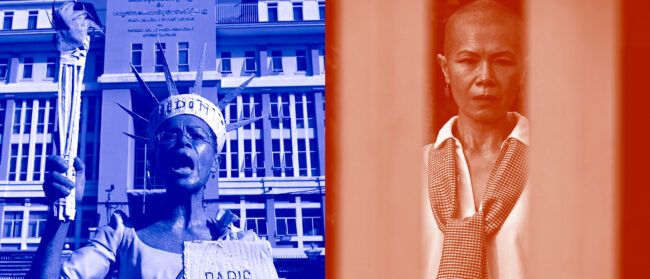Huddled around a candle, the elders of the Putrom community, a group of three indigenous Bunong villages in Cambodia’s northeastern Mondulkiri province, summoned the final guests to their elephant’s wedding in Keo Seima forest.
The elders tossed rice at the wick, waiting for their deceased ancestors and the surrounding forest spirits to reveal their presence. When the candlelight flickered or a piece of grain stood straight in the wax, the spirits and ancestors were listening.
“We have the feeling inside of us that they are here,” said Chhael Plouk, one of the ceremony’s leaders and head mahout of the Elephant Valley Project (EVP), a sanctuary run by conservation NGO Elephant Livelihood Initiative Environment (ELIE).
Plouk told the attending spirits and ancestors the news: for the first time in decades, a baby elephant was born. Forty-year-old Plouk could not remember the last time his village held a marriage ceremony for an elephant.

To avoid inflicting spiritual harm upon their community, Plouk and his fellow mahouts had kept baby elephant Gee Pich deep in the Keo Seima protected forest until the elders could bless the baby and hold a wedding for its mother, Gee Pael, nicknamed Pearl. The groom was absent.
“She has a husband but we don’t know where he is,” Plouk said with a laugh.
A wild bull had entered the EVP sanctuary and ran off with Pearl for two weeks in 2020 before she returned, giving birth in March after a 23 month gestation period. Plouk explained that, like people, the parents of a baby must be bound by marriage or else sickness and harm will inflict the village according to Bunong beliefs.
The Bunong are one of an estimated 24 indigenous peoples representing less than 2% of Cambodia’s population of 16 million, which is dominated by the Khmer majority. While historically the Bunong kept elephants, there are now only around 74 captive elephants in Cambodia and about 400 in the wild. Some villagers train as elephant caretakers known as mahouts to watch over 12 elephants in collaboration with EVP.


Baby Gee Pich is the first elephant born in the Putrom community in decades. While the village has a long history of raising elephants for transportation and labour, the tradition has faded with modern technology, deforestation and the high cost of caring for them
Held in early May, the wedding for Pearl resembled a human wedding in Bunong culture. With help from ELIE, the community collected two chickens, two pigs, a duck, a dog, a cow and a buffalo.
In the morning, representatives from various families in the Putrom community gathered at the site of Gee Pich’s birth near a dried up creek bed in the forest, sacrificing each animal. Their blood and meat were shared with the ancestors and spirits out of respect, before the community could feast. Working together, the men and women skinned and sliced, grilled and boiled, until simmering pots were filled with every part of the animal, from the intestines to the stomach lining.


The elders clustered around a nearby rock, dabbing their fingers in a cup of blood, tracing the rock’s outline and adding bits of rice and meat. Speaking at the same time, each participating villager shared the story of Gee Pich’s birth, beginning with Pearl’s elopement to the current sacrifices and hopes for the elephants’ future.
At intervals, the villagers took long sips of rice wine, offering some to the spirits and ancestors by spilling drops over the decapitated cow and buffalo heads.

Once the sacrifices were completed, family representatives passed under a branch of leaves fashioned into an arch, many carrying bundles of clothing on behalf of absent relatives.
As one of the village’s spiritual matriarchs, Plouk’s wife Yan Rai blessed each forehead and every bundle, smiling at the children and joking with the teenagers.



Rai blesses each community member, as well as the bags of clothes they bring on behalf of relatives not in attendance.
She also blessed Jemma Bullock, ELIE’s programme manager, an Australian who has been working with the community for more than 12 years.
For Bullock, maintaining Bunong cultural practices is part of a larger conservation strategy. EVP’s elephants spend most of their days far in the forest with their Bunong mahouts, who watch over them as they grase and sleep semi-wild life, free from work. The elephants are kept on long chains tied to trees at night, but otherwise are left unrestrained during the day. Tourists who pay to visit EVP are not allowed to touch or ride the animals.
Yet Bullock understands the importance of maintaining the elephants’ ties with Bunong culture. She supports the village’s occasional elephant-related ceremonies, even though they involve touching, riding and a degree of stress for the animals.
“Elephants have been part of this community for thousands of years,” she said. “We can’t disconnect that from the local community, because they live in their forest. If they have a strong connection to the elephants, we can protect the forest and the habitat for these elephants to live their lives in peace.”



To prevent overwhelming the infant with too many people, the elders waited until late May to introduce Gee Pich to the Putrom community, conducting the ceremony on the forested outskirts of one of the villages, along with five other elephants. Later, another six elephants were brought to the head mahout‘s house for further blessing. A cantankerous bull in heat was not allowed to attend.
These ceremonies help the elephants remember their relationship to the village, Rai said.
“They have been in the forest so long,” she said. “We want to show them where we sleep, where we eat, so they remember us.”
Besides the advice she recalled from elders over the years, Rai also looked to her deceased mother, who she said appeared in her dreams, for guidance on how to lead the ceremony.
Deceased ancestors and forest spirits are in constant conversation with the elephants as well, said Breng Chanthy, an elder whose family owns an elephant rented to EVP. The Bunong believe elephants hear through their trunks and their feet, listening to the earth and its spirits.
“They [the elephants] know when we did good or bad,” Chanthy said. “They know before anyone else.”
Outside of Plouk and Rai’s home, villagers watched six elephants line up, mahouts astride their shoulders. School children stopped in the road to stare as the elephants munched on the bamboo heaped before them.
Murmuring individual blessings, the elders approached with bowls of rice and wine to dab upon the wrinkled elephant skin, the wine running through the creases like rain down a mountainside. The elephants vibrated with low, peaceful rumbles.
When the ceremony was complete, the elephants trundled away back to the forest. Baby Gee Pich will spend most of her days living in EVP’s forested sanctuary with her. But today, the elders said, she finally became part of the community.
Photos by Jack Brook for Southeast Asia Globe


